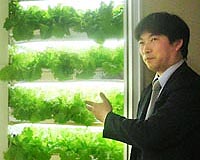 |
for Astrobiology Magazine Moffett Field CA (SPX) Jul 17, 2009 Does a sandwich on Mars taste different? The answer could be no, according to new research that found long-term spaceflight exposure doesn't change later generations of wheat seeds. Molecular biologist Robert Ferl of the University of Florida and colleagues studied wheat seeds descended from plants that flew on the Russian Mir space station. The progenitor plants were in space for 167 days in 1991. When they were brought back to Earth, the plants gave rise to viable offspring seeds. After four generations of plants were grown from the seeds, the researchers analyzed gene expression in the descendant wheat plants as a sensitive measure of potential lasting effects of spaceflight. They looked at thousands of genes and found no significant changes in how those genes were expressed between their test plants and a control group of plants whose forebears were never in space.
Still wheat Ferl said the findings offered promising evidence that growing plants on other worlds might not be that hard. People should be able to pack up a bunch of seeds for their favorite foods, and after an extended microgravity journey, land on another planet and grow the seeds without ill consequence. Previous research found that the weightless environment of spaceflight isn't a serious impediment to plant growth, though plants do often grow differently in microgravity - sometimes even taller, without gravity to pull them down. "Plants, while they are in orbit, do exhibit changes in gene expression because that is a different environment," Ferl said. But no one had yet tested whether any changes occurring in the plants during their spaceflight experience were passed on to future generations. This new study, published in the May 2009 edition of the journal Astrobiology, found this does not seem to be the case. "We can still expect wheat plants to be wheat plants once they get to Mars," Ferl said.
New challenges For one, while plants are in space and on other planets, they could be exposed to strong radiation from the sun and cosmic rays. On Earth, we are blocked from the worst of this radiation by our protective atmosphere and magnetic field. The average journey to Mars would take 6 months (180 days), and then the plant seeds would be exposed to higher levels of radiation while on Mars due to the Red Planet's thinner atmosphere. "I do think accumulated radiation damage over time could become an issue," Ferl said. Dealing with radiation danger is a top priority for scientists planning future space exploration missions, because humans as well as plants are vulnerable to damage from energetic radiation. Engineers must design strong shielding for both space ships and planet habitats. Another difficulty may be what kind of soil to grow the plants in. While some necessary minerals may already exist on other planets that can be used for agriculture, other vital plant nutrients might have to be carried over from Earth. Because shipping heavy materials via rocket is expensive, as many materials as possible must be mined or created in the new environment. Mars soil is rich in sulfur, and it is unknown at this time if seeds from Earth would prosper or fail in the alien red soil. Plants on Earth also rely on a rich microbial diversity within the soil to carry out many functions. Mars, as far as we know, has no such organisms in its soil, so the plant-friendly soil microbes would probably need to be transported to Mars along with the seeds. Share This Article With Planet Earth
Related Links University of Florida Space Tourism, Space Transport and Space Exploration News
 Green Room helping Japanese expedition
Green Room helping Japanese expeditionMatsudo, Japan (UPI) Jul 4, 2009 The head of a Japanese expedition in the Antarctic says so-called Green Room growth techniques have proved invaluable to the researchers. xpedition leader Shuki Ushio said the Japanese agricultural breakthrough that uses fluorescent lights to grow vegetables indoors has allowed expedition members to eat more than simple freeze-dried food products, Kyodo News reported Saturday. ... read more |
|
| The content herein, unless otherwise known to be public domain, are Copyright 1995-2009 - SpaceDaily. AFP and UPI Wire Stories are copyright Agence France-Presse and United Press International. ESA Portal Reports are copyright European Space Agency. All NASA sourced material is public domain. Additional copyrights may apply in whole or part to other bona fide parties. Advertising does not imply endorsement,agreement or approval of any opinions, statements or information provided by SpaceDaily on any Web page published or hosted by SpaceDaily. Privacy Statement |